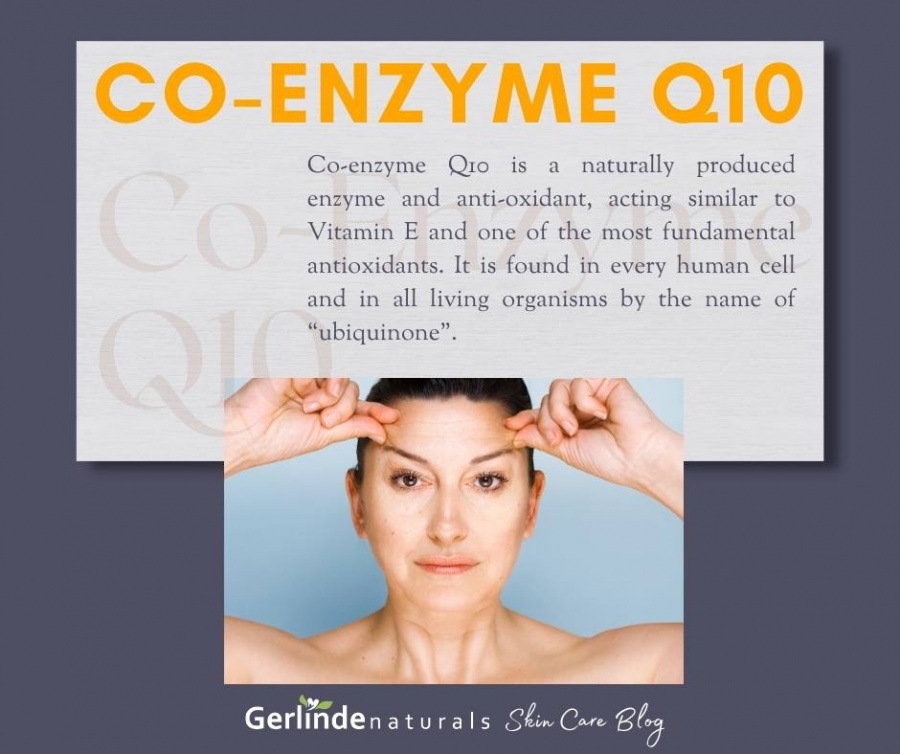What exactly is Coenzyme Q10?

Co-enzyme Q10 is a naturally produced enzyme and anti-oxidant, acting similar to Vitamin E and one of the most fundamental antioxidants. It is found in every human cell and in all living organisms by the name of “ubiquinone”.
Studies have found that orally supplementing the body's supply of Co-enzyme Q10 can offer numerous health benefits for heart health, eliminating migraine headaches, easing the suffering from cancer treatments, lowering blood pressure and many more. Yet sceptics question the value of taking Co-enzyme Q10 in pill form. They contend that it loses its potency while traveling through the digestive tract.
Benefits of CoQ10 for Skin
When we're younger we're able to produce as much CoQ10 as we need for energy. As we get older, aging and stress slow down the CoQ10 creation process and our supplies diminish. Coenzyme Q10 in humans begins at low levels when we are young, peaks in our late teens, and begins to decline after 20 years of age.
While naturally occurring CoQ10 can be digested for energy, it can do a number of things in skincare products. In terms of skincare, it's usually in toners, moisturisers and under-eye creams, promising to help stimulate collagen production, even skin tone, reduce sun damage and the appearance of fine lines.
- Energises cell activity: This energy is needed to repair damage and make sure the skin cells are healthy. Active skin cells get rid of toxins easily and can make better use of nutrients. When your skin ages, all these processes slow down, causing dull and sallow, wrinkled skin.
- Reduce sun damage: The skin is damaged by exposure to the sun's UV rays, which provides a source of free radicals, which can be damaging to the cells' DNA. The potent antioxidant function of CoQ10 helps it to protect the skin at the molecular level from the damaging effects of the sun and from damage by free radicals. It works by "decreasing the collagen degradation of skin and interdicting the damage caused by photo-aging."
- Even out skin tone: CoQ10 works to block tyrosinase, which helps with the production of melanin, which means that CoQ10 can help fade and prevent dark spots.
- Stimulate collagen and elastin production: CoQ10 supports the body's ability to produce collagen and elastin.
- Replenishes skin cells: More energized skin cells mean healthier skin cells. Adding CoQ10 to your skincare may allow your cells to better utilize other nutrients, leading to healthier skin overall.
- Helps reduce damage of free radicals: Since CoQ10 aids in cell activity, it also means that your cells can be more efficient in flushing out toxins like free radicals and healing the damage they cause.
- Reduces the appearance of wrinkles and fine lines: This ingredient helps your body produce collagen and elastin, which can reduce the appearance of fine lines.
How did it get discovered?
‘The discovery of Co-enzyme Q10 occurred in 1957 with the work of Professor Fredrick L. Crane and his team at the University of Wisconsin–Madison. A year later Dr. Karl Folkers properly identified the chemical structure of the nutrient. Inquiry into the health benefits of Coenzyme Q10 did not widely occur until the 1980s, and as a result, the nutrient did not begin appearing in skin care products until the 1990s and early 2000s.’
The ingredient is used widely in skin systems intended to prevent aging and to make existing wrinkles less noticeable. The nutrient is also used in stand-alone skin care treatments, such as masks, serums and lotions. Most skin care experts agree that in order for a product to offer real benefits it must contain a concentration of at least .5 percent Co-enzyme Q10.
Since Co-enzyme Q10 has a deep orange colour, skin creams and lotions become usually slightly yellowish or orange if there is a biologically significant amount of Co-enzyme Q10 in the product. Thus, the colour of a product gives you a hint whether the product contains significant amounts of Co-enzyme Q10 or not.
How does it get produced?
‘There are several ways to manufacture CoQ10:
• Extraction from Natural Resources: Since CoQ10 occurs at very low concentrations in natural resources and is extremely difficult to purify, industrial manufacture of natural CoQ10 is not a practical option and would lead to exorbitant prices.
• Chemical Synthesis from a Natural Derivative: CoQ10 can be synthesize by using solanesol, an extracted from plant material from the Eggplant family, which is converted to a nine-isoprenoid compound (decaprenol) and reacted with hydroquinone to produce CoQ10.
• Microorganism Method: Microorganisms such as yeast or bacteria can be stimulated to produce repeated mutations, thereby enhancing their capacity to synthesize CoQ10.
Moisture Boost Serum with Co-enzyme Q10
